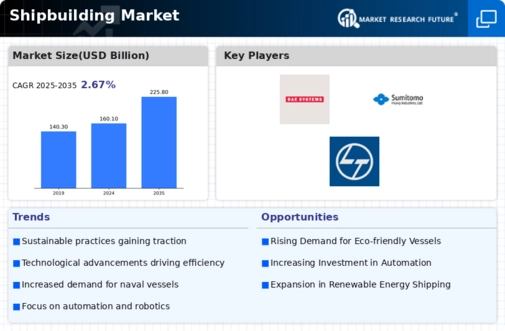Shipbuilding Size
Shipbuilding Market Growth Projections and Opportunities
The Shipbuilding Market operates within a dynamic framework influenced by a multitude of interconnected market factors that significantly shape its growth, direction, and competitiveness.
Global trade and economic conditions serve as fundamental drivers of the Shipbuilding Market. The demand for new vessels often correlates with global economic trends and trade volumes. During periods of economic expansion, increased trade activities necessitate additional vessels to support transportation, leading to a surge in shipbuilding orders. Conversely, economic downturns or fluctuations in trade volumes can impact shipbuilding demand as shipping companies and maritime operators reassess their fleet expansion plans.
Government policies and defense spending significantly impact the Shipbuilding Market. Defense contracts for naval vessels, including warships, submarines, and support vessels, play a pivotal role in shipbuilding. Governments worldwide allocate budgets for naval modernization and maritime security, driving demand for vessels in the defense sector. Shipbuilders often rely on government contracts and military programs to sustain operations and secure a portion of the market.
Technological advancements and innovation stand as critical factors shaping the Shipbuilding Market. Continuous advancements in vessel design, propulsion systems, materials, and manufacturing techniques drive the evolution of shipbuilding. Shipbuilders invest in research and development to integrate cutting-edge technologies, such as automation, digitalization, and eco-friendly propulsion systems, into vessel construction. Innovation enables the creation of more fuel-efficient, environmentally sustainable, and technologically advanced vessels, catering to evolving market demands.
Environmental regulations and sustainability considerations play an increasingly influential role in the shipbuilding industry. The sector faces growing pressure to adopt eco-friendly practices and reduce carbon emissions. Shipbuilders are transitioning toward constructing vessels that comply with stringent environmental regulations, incorporating features like ballast water treatment systems and utilizing cleaner propulsion technologies. Meeting these regulatory standards is crucial for shipbuilders to remain competitive and meet the sustainability demands of customers and regulatory bodies.
Market demand dynamics also significantly impact the Shipbuilding Market. The demand for different types of vessels, such as container ships, tankers, bulk carriers, cruise ships, and specialized vessels for offshore industries, varies based on economic conditions, industry requirements, and global trade patterns. Shifts in global trade routes, changes in cargo types, or emerging industries like offshore renewable energy influence the types and specifications of vessels required, affecting shipbuilding orders.
Geopolitical factors, including trade policies, international relations, and regional conflicts, can impact the Shipbuilding Market. Trade tensions, tariffs, or geopolitical instability in key shipping regions can disrupt trade flows, influencing shipping patterns and thereby affecting shipbuilding demand. Additionally, changes in shipping regulations or geopolitical shifts may prompt shipowners to reconsider vessel orders or fleet expansions, impacting shipbuilding dynamics.
Moreover, fluctuating steel prices, currency exchange rates, and raw material availability significantly influence shipbuilding costs and profitability. The Shipbuilding Market relies heavily on steel and other raw materials for vessel construction. Any fluctuations or disruptions in raw material supply chains can impact shipbuilding operations, production schedules, and overall costs.
In conclusion, the Shipbuilding Market operates within a complex environment shaped by diverse market factors, including global economic conditions, government policies, technological advancements, environmental regulations, market demand dynamics, geopolitical factors, and raw material availability. Successfully navigating these market factors demands adaptability, innovation, stringent compliance with regulations, and a deep understanding of industry trends. Shipbuilders that effectively navigate these factors position themselves for sustained growth and competitiveness in this dynamic and ever-evolving industry.







Leave a Comment